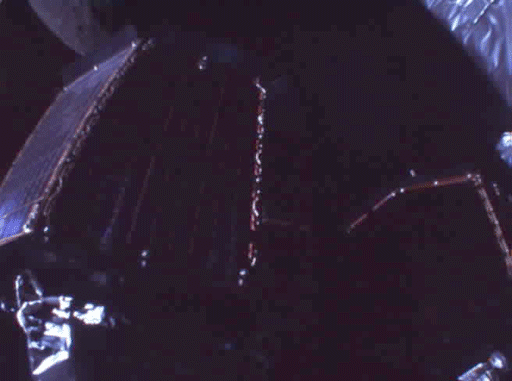Emily Lakdawalla • Oct 12, 2007
Kaguya: both mini-satellites deployed and renamed
JAXA announced today the successful deployment of the second of Kaguya's two mini-satellites. And, in what seems to be a traditional act of the Japanese space program following the "launch" of a spacecraft, they have given "nicknames" of mythological origin to the two spacecraft: Okina and Ouna. Okina and Ouna, meaning "honorable elderly man" and "honorable elderly woman," refer to the old couple who adopted and raised the moon princess Kaguya in the Tale of the Bamboo Cutter. Sometimes these mythological names come to supplant the original name -- as happened to Hayabusa (formerly known as MUSES-C) -- but sometimes the former, technical names remain in common use. Given the choice, I prefer the mythological names, so I'll probably stick with those.
As before, they released a couple of onboard camera photos of the successful deployment, so I assembled the four images into an animation.

JAXA
Kaguya deploys its mini-satellites
Views from a small onboard camera show the successful deployment of the lunar orbiter Kaguya's two mini-satellites. Each mini-satellite is an octagonal prism one meter in diameter with solar cells covering its 0.65-meter-long sides; the satellites will be used in a radio interferometry experiment to map the Moon's gravity. The first satellite, Okina (also known as the Relay satellite or Rstar), was released on October 9, 2007 into an elliptical orbit 100 by 2,400 kilomters in size (first two frames). The second satellite, Ouna (also known as the VRAD satellite or Vstar), was released on October 12, 2007 into an elliptical orbit 100 by 800 kilometers in size (last two frames).Also, something else to keep your eyes out for: Chang'E 1 is supposed to be launching some time this month, probably toward the end of the month. When I hear any news about this mission I'll post it.
Support our core enterprises
Your support powers our mission to explore worlds, find life, and defend Earth. You make all the difference when you make a gift. Give today!
Donate

 Explore Worlds
Explore Worlds Find Life
Find Life Defend Earth
Defend Earth

